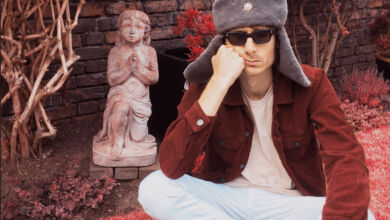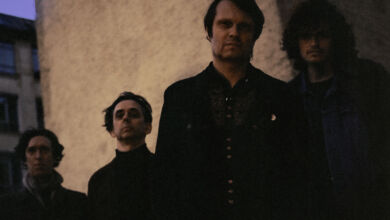
The Incredibly Strange Record Club
Various Artists
Inspired by the Cramps crazy record collection Volume One: Fungus, Stockings, Torture, Beatniks, Robots and Nonsense.
According to the compilers of The Incredibly Strange Record Club, this compilation of oddball novelty 45rpms was inspired by The Cramps record collection. Those of you who are familiar with The Cramps brand of sleazy, amped up Rock n Roll will surely understand what is on this collection and will love it as a result. The Cramps were well known as record collectors and their penchant for 1950s Rock n Roll provided the template for their own take on the genre and they were arguably the forerunners of the Psychobilly genre, which emerged in the late 70s and early 80s.
Trying to sum up The Cramps is no easy feat and the same goes for this compilation, it embodies everything that The Cramps distilled to such lethal and deranged effect. The album delves into all kinds of subject matter, which is often hilariously nonsensical and at times just plane gibberish. The album broadly encompasses, trashy and camp Rock n Roll, Country, RnB, Jazz, spoken word, Doo Wop, sleazy Rock n Roll instrumentals, with exotic jungles noises thrown in for good measure.
The music is largely drawn from the mid to late 1950s with a smattering of songs from around 1960/61, and the oddity and unpredictability of this album will be very appealing to those with a discerning ear for the weird and the bizarre. Tommy Blake kicks things off with F-olding Money a cool bit of swinging Rock n Roll, in which he adopts two voices and it is a tale of a man who is down on his luck and when all means of legally making money are denied him, he resorts to bravado and violence to justify what he sees as the unfairness of his situation. But all he ends up with is a jail sentence and it could be argued that this song is more autobiographical than perhaps Tommy Blake intended.
There are also a number of tracks that celebrate the dance crazes of the late 1950s and early 1960s, including Jerry Dallman and the Knightcaps The Bug, and an instrumental by Big Walter and the Thunderbirds Watusie Freeze PT 1. The latter tune in particular is referencing a popular solo dance routine that hit its peak in the early 1960s, and this bizarre and exotic sounding tune comes with jungle noises and a tribal drum rhythm, which propels the track along.
However, the appeal of the album lies in the perfectly nonsensical and tongue in cheek nature of the songs. Jamie Horton’s Robot Man tells the tale of a rapturous girlfriend who finds the love of a robot (which she can control with a key) preferable to a straying, lying, fighting and cheating man. The absurdities continue with the hilariously gibberish Rubber Biscuit by The Chips, and Mope-iity Moope by The Boss Tones. These wonderful pieces of offbeat nonsense can’t be taken seriously at all when considering that the subject matter is eating rubber biscuits that ricochet off walls and a trip back from space with a woman who everyone comes to see do the Bop.
The album comes to a conclusion with a couple of haunting instrumentals and a couple of spoken word tracks, which considering the subject matter segue into each other perfectly. Lullaby of the Doomed by Babs Gonzales is a jazz tinged spoken word tune that mourns the loss of a loved one, followed by Ed’s Place by Horace Heller, which is a macabre confessional piece about infidelity, and the reaction of a jealous lover who resorts to the willful murder of his love rival and the so called accidental murder of his lover. Some might say a song about murder should not be amusing, but in the hands of Horace Heller the story takes a few twists and turns as the perpetrator unburdens his conscience on the listener, before calling the police to confess his murderous deeds.
Having to endure 26 tracks on any album can be somewhat trying even for the most dedicated of music fan. However, this compilation does not outstay its welcome due to the absurdity and humour displayed on many of the tracks. The album as a whole encompasses a curious mix of silliness, murderous intent, the surreal, lurid, and macabre that it is worth shelling out a paltry tenner as it is quite unlikely that many music fans will have an odd-ball compilation like this in their collection. BUY HERE!
Shapes and Shadows
Psychedelic Pop and other rare flavours from the Chapter One vaults 1968-1972
A compilation for late 1960s rare Psych and Pop aficionados, who do not want to spend a fortune on Ebay trying to hunt down these rarities can now enjoy hearing these carefully chosen tracks on one album. Les Reed OBE, a highly successful (if not well-known) songwriter, founded the Chapter One label in 1968, and throughout the 1960s Reed was writing songs at a prolific rate, which were covered by a myriad of artists including, Gene Pitney, Tom Jones, Elvis Presley, Connie Francis, Wayne Fontana, Petula Clark, Shirley Bassey to name a few.
However, by 1968 Les Reed decided to start what can be considered one of the first independent labels, for fledgling new artists and bands. It could be argued that Les Reed may have been following in the path of Andrew Loog Oldham’s Immediate label, except Chapter One never had the same kudos and sadly did not enjoy the same level of commercial success of Immediate, and after ever diminishing chart returns the inevitable happened and by 1973 the label folded. It will amuse many to know that one of the labels biggest hits came in the form of a football song. Step forward Gerry Monroe and Leeds United F.C, who recorded Marching On Together for the 1972 F.A Cup Final, and is still sung by Leeds United fans on the terraces of Elland Road to this day.
Les Reed has given Cherry Red Records subsidiary Grapefruit Records his full backing to raid the vaults of Chapter One, and what they have assembled is an album that will largely appeal to collectors and completists of late 60s early 70s Psychedelic tinged pop. As usual Grapefruit Records have done an excellent job with the packaging, and the artwork, rare photos and the 14 pages of sleeve notes make this a tempting purchase before a song has even been heard.
It would be fair to say that compilations of this sort can be hit and miss and some of the tracks on here were not hits for a reason, but then most of us know that some of the best music ever released did not sell. ‘The record buying public shouldn’t be voting’. The real interest for collectors will be the handful of tracks by the Episode Six. This band released nine singles between 1966 and 1969, five of which grace this compilation. Sadly not even once did this band trouble the charts, and now they are probably best known (rather unfairly) as the band that spawned the careers of Ian Gillan and Roger Glover who went on to superstardom in the band Deep Purple.
The Episode Six’s output for Chapter One varies somewhere between Pop, Rock and Psych and as a result of this toe dipping into different genres their output does vary in quality. However, the band did have some heavier, funkier moments, which are included on this album such as Jack D’Or and Mozart Versus the Rest, which were both released in 1969. There is also some rare footage on You Tube of the band performing Morning Dew and I Hear Trumpets Blow in 1967. The latter song in particular shows their leniencies towards pop, but they did a pleasing version of Bonnie Dobson’s Morning Dew. But one gets a sneaking suspicion that The Grateful Dead and Nazareth’s versions of the song would be the preferred choice for many listeners.
There must have been something in the air in St Albans in the 1960s, as this was the place that gave birth to Donovan and the Zombies. Both of whom were the purveyors of music that more often than not erred on the side of wistfulness and whimsy. Following very closely in their footsteps were a little known outfit called Bliss whose Courtyards of Castile and Lifetime are both included on this album. Both of these songs may be considered in the Psych/Folk genre, however, there is certainly no freak out moments on this pair of haunting singles and the intrigue of these songs will be in their scarcity. Bliss and Chapter One must not have been too concerned with the commercial viability of these singles as they so readily demonstrate a melancholy and wistfulness that pre dated the Zombies somewhat sombre classic Odessey and Oracle by the best part of a year.
Why anyone would want to name their band Putney Bridge will be beyond most of us, however, such is the dearth of information on this band that the name does at least tell us where they are from. The three songs included here all date between 1970 and 1972, and album opener What’s It All About is a pleasant enough pop song and is by far the most hit worthy song of the three. Your Turn To Die has a Prog meets white boy blues feel to it, with a blistering but over played lead guitar, and the Meaning Of Love kicks off with a twin assault of fuzz guitar and Hammond intro, which would sound like bliss to many, but the lyrics are cringeworthy. Harmony among the races is to be applauded, but in the hands of Putney Bridge this song just sounds like a load of pseudo hippy nonsense and comes across as trite and patronizing.
The rest of the album demonstrates the softer side of UK based guitar bands in the late 1960s and early 1970s. Morning Glory, Sad People, and The March Hare best demonstrate this. It is a moot point of discussion how any of these bands can get lumped into the Psych genre, when really you could argue that this music is just schlock and is given some sort of kudos and merit by including it on a compilation that implies that it is indeed Psychedelia. The appeal of this album lies in the fact that all these songs are ridiculously obscure, which makes this album an intriguing purchase for musicologists and completists of pop music in this period. BUY HERE!








